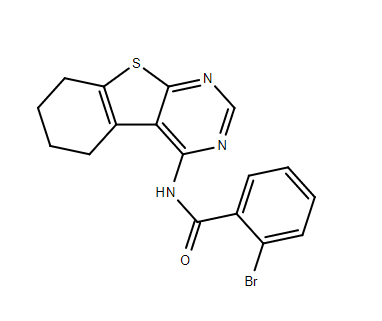| Cas No.: | 302939-48-6 |
| Chemical Name: | KL201 |
| Synonyms: | KL201;KL-201;KL 201 |
| SMILES: | O=C(NC1=C(C2=C(CCCC2)S3)C3=NC=N1)C4=CC=CC=C4Br |
| Formula: | C17H14BrN3Os |
| M.Wt: | 388.28 |
| Purity: | >98% |
| Sotrage: | 2 years -20°C Powder, 2 weeks 4°C in DMSO, 6 months -80°C in DMSO |
| Description: | KL201 a circadian clock modulator, is a isoform-selective cryptochrome 1 (CRY1) stabilizer. KL201 has no stabilizing effect on CRY2. KL201 lengthens the period of circadian rhythms in cells and tissues[1]. |
| In Vitro: | KL201 causes dose-dependent lengthening of circadian period in Bmal1-dLuc reporter cells, and in cells with another circadian reporter Per2-dLuc. KL201 suppresses the intensity of Per2-dLuc reporter much more than that of Bmal1-dLuc, without affecting cellular viability[1]. KL201 binds to CRY1 in overlap with FBXL3, a subunit of ubiquitin ligase complex, and the effect of KL201 is blunted by knockdown of FBXL3[1]. KL201 lengthened circadian period and suppressed the intensity of Per2::Luc knockin reporter in mouse lung primary explants[1]. |
| References: | [1]. Simon Miller, et al. An Isoform-Selective Modulator of Cryptochrome 1 Regulates Circadian Rhythms in Mammals. Cell Chem Biol. 2020 Sep 17;27(9):1192-1198.e5. |

 To enhance service speed and avoid tariff delays, we've opened a US warehouse. All US orders ship directly from our US facility.
To enhance service speed and avoid tariff delays, we've opened a US warehouse. All US orders ship directly from our US facility.




















